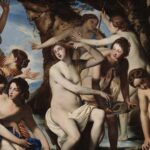The Vittoria Alata is one of the most extraordinary statues of the Roman era, symbol of the city of Brescia kept in the Capitolium.
A work loved by Giosuè Carducci who celebrated it in the ode Alla Vittoria and also admired by Gabriele d’Annunzio and Napoleon III, it is still today considered one of the most important artworks of Roman times in terms of composition, material and conservation.
The Vittoria Alata was found on July 20, 1826 together with six imperial heads and hundreds of other bronze finds, inside a cavity of the ancient Capitoline Temple.
Thanks to the ingenious hiding place that has protected it over the centuries, it has come down to the present day.
Studied about the Vittoria Alata
the Vittoria Alata,initially considered as an ellenistic artworks (dated III century a.C.) and later on placed in roman imperial era, it was subsequently recognized as born from the superimposition of previous works and created in the Roman age, around 69 AD.

But who was the Vittoria Alata?
Ahe was Afrodite who was mirrored Ares’, shield supported by both hands without making contact with the leg.
It is sculpted in movement: the twisting of the bust and the movement of the arms are inspired by Greek works from the 5th-6th century BC.
The left leg is slightly raised as it is believed that the foot rested on the helmet of Marte; to complete the sculpture, a silver and copper damascening was placed on the head to encircle the hair.
The flight to Rome and the return to Brescia
When the First World War broke out, Vittoria Alata was transferred to Rome to protect her and keep her away from the front lines.
After the conflict it was Pompeo Gherardo Molmenti, senator and undersecretary for antiquities and the fine arts, who took charge of the transport and return of the Vittoria to Brescia.
He returned to the city in April 1920.

But how did it get to Brescia?
According to the first studies, it would have been transported to Rome by the will of Augustus after the death of Cleopatra in 29 BC. and therefore donated by him to Brixia.
The sculpture would then be transformed into Nike following the second battle of Bedriaco by Vespasian’s will.
The attitude of the goddess would have changed from the vanity of looking in the mirror to the act of writing a dedicatory inscription on Ares’ shield with a stylus, which was later lost, while the two large feathered wings would have been mounted on her back.
In 2018, the artwork was entrusted to the experts of the Opificio delle Pietre dure and subjected to a major restoration.
The studies undertaken have highlighted some technical aspects for which the previously exposed hypothesis has slightly lost its veracity.
In any case, whatever the story that brought the Vittorie Alata to Brescia, today it is an essential symbol.













